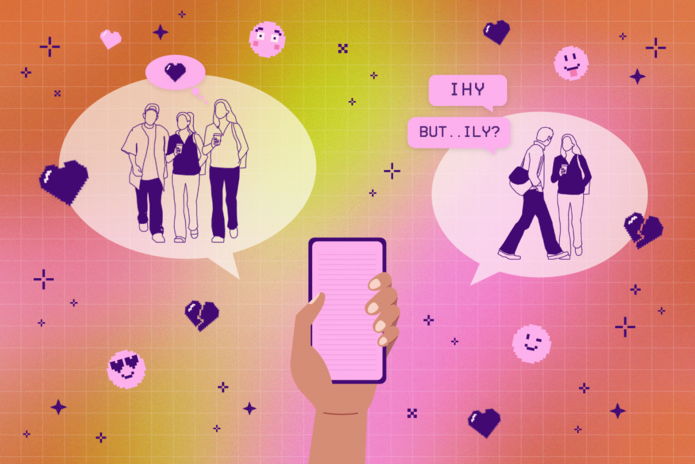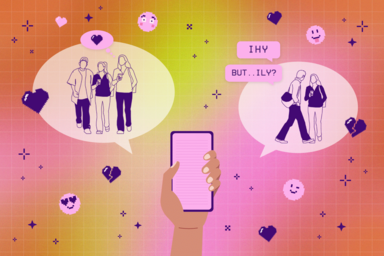There’s an old-fashioned Irish tradition that “allows” women to propose to their partners every Leap Day. Of course, women can propose to their partners whenever they want, but this tradition also happens to be the plot of Leap Year, one of my favorite movies. It’s the kind of film I can watch over and over, despite the bad reviews on Rotten Tomatoes, and it hits so many of the romance tropes on my list of favorites. In the film, Boston-based real estate stager Anna decides to surprise her boyfriend, Jeremy, with a proposal. On her way to Dublin – where Jeremy is on a business trip – destiny and many other romantic clichés lead her on a journey with a charming Irish man, Declan. From enemies to lovers, the one-bed trope, and, of course, the grumpy-sunshine trope, Leap Year is chock full of some of my favorite romantic story arcs.
Man, I love a cliché — and with good reason. Feel-good movies can truly boost anyone’s mood by helping us detach from reality. According to a 2019 study conducted by Michael J. Rosenfeld, Reuben J. Thomas, and Sonia Hausen, “Disintermediating your friends: How online dating in the United States displaces other ways of meeting,” dating apps are the most popular way of meeting a romantic partner in real life and meet-cutes are as rare as ever. So, where do these romantic tropes come from? Are romance authors just exercising their creative autonomy and using their imagination? Or is it possible to experience a romance trope IRL?
I spoke to five young women who’ve found themselves front and center of some of the most popular romance tropes on the list. Below, they share their main character moments.
The Enemies-To-Lovers Trope
Chanel, 17, has experienced an enemies-to-lovers relationship firsthand. She’s always been a fan of the trope and adores books like The Hating Game by Sally Thorne, The Unhoneymooners by Christina Lauren, and The Cruel Prince by Holly Black. Because of her love for those types of stories, she recognized the start of an enemies-to-lovers relationship when she met Elijah,* one of her cousin’s best friends.
The two met at a family barbecue. Chanel’s cousin, James,* didn’t want his friend dating one of his family members, which led to the two bickering and arguing. At first, Chanel was happy. “I’ve read plenty of stories with an enemies-to-lovers plot, and to experience it was quite a thrill,” she tells Her Campus. But as their fighting escalated, she started to feel genuine resentment towards him. “I’d see him around and [send him] death stares; he’d talk about me behind my back and avoid me in public,” she says. “There were lots of little things he did that would just irritate me.”
To quote Sally Thorne in The Hating Game, “Hating someone feels disturbingly similar to being in love with them.” According to a 2008 study published by neurobiologist Semi Zeki and researcher John Romaya, the same areas of the brain are activated when a person looks at a photograph of someone they love and someone they hate, which means there’s a correlation between the two emotions.
And that’s exactly how Chanel felt. “The more I ended up seeing him, the more I talked to him, [and] the more I realized that he wasn’t as bad as I made him out to be,” she says. “He still teased me, but I could see a difference in how he acted towards me. I was quite surprised – I didn’t think he’d ever give me a chance, but we started hanging out just the two of us. That’s when I realized I liked him.”
When they both realized their relationship had been upgraded from enemies to lovers, they started seeing each other in secret. “He was afraid to tell my cousin that we were together,” she says. “He said he didn’t want to lose James’ friendship, but I think it was because he was embarrassed of me.” In the end, the relationship wasn’t the healthiest. “We didn’t end on good terms, and now we’re back to enemies,” Chanel says.
The Friends-To-Lovers Trope
Leigh,* 21, met her current boyfriend, Jesse,* on her first day at college. “My roommate asked me to come to Times Square with her and some people she knew,” she tells Her Campus. “I almost didn’t go because I was so tired from moving, but I met Jesse that day.”
Leigh and Jesse became really good friends, but she wasn’t looking for a relationship initially. “Over time, I kind of let my walls down because he made me feel so comfortable,” she says. Unfortunately, they lost touch for a couple of years but recently reconnected. “During quarantine, I downloaded Bumble out of pure boredom, not expecting anything to come from it,” she says. “Jesse popped up in the list of people who had ‘liked’ me, and I was surprised.” Their relationship had never been romantic, but it turned from friends to lovers.
According to a 2021 study from the Journal of Social Psychological and Personality Science, 68.2% of the 1900 participants reported that they’d experienced a friends-to-lovers relationship in real life. It just makes sense, right? By being friends with someone, you already know their best characteristics, worst flaws, and how your personalities interact, which is probably why it’s so beautiful to watch or read about. Two people who already love each other and know each other below the surface level? It can’t get any cuter.
“I love friends-to-lovers romance tropes,” Leigh says. “Percy and Annabeth from Percy Jackson & The Olympians are still one of my favorite literary couples of all time.” With a friends-to-lovers relationship, each party has a solid idea of what they’re going to get before they ever decide to pursue the relationship. “There was already a bond before we started anything romantic — It’s less superficial like that,” she says. “Plus, we don’t have to say that we met on Bumble. It’s also fun to hear people say stuff like, ‘I knew it!’ when you tell them.”
Corinne, 23, met her current boyfriend at Virginia Tech. “He was actually the RA for my hall,” she tells Her Campus. “He was in his senior year at the time, and all of the girls in my suite thought he was super cute. He was, of course, the cool, hot, older guy to us. Our friendship is really what [sparked my] interest in him. He was always there to talk to and had such a fun personality. We would have conversations in each other’s dorms or pass by in the halls and not realize how much time had gone by because he was so easy to talk to.”
They didn’t start dating until much later, during Corinne’s senior year. “We’d kept up and chatted a few times since he’d graduated, but he lived in a different state, and we always seemed to be seeing other people at opposite times,” she says. Corinne didn’t even know he had feelings for her until he replied to a tweet between her and her old roommates one day. “After that, he talked to me for days on end,” she says. “Eventually, I joked about how everyone had a crush on him back then, and he told me how he’d wanted to be with me then but was afraid of losing his job.” The two started dating long distances at the beginning of the pandemic and then met up when it was safer to do so. He attended a wedding with her last fall, and they both moved to the DC area this summer.
Corinne agrees with Leigh about the best parts of having a friends-to-lovers relationship. “It’s great not to have to go through that awkward first date and the phase of getting to know someone,” she says. “I’d never felt so naturally comfortable with someone.”
The One Bed Trope
Ah, the one-bed trope: very popular, frequently featured in fanfiction, and a situation filled with sexual tension. But sometimes fantasy becomes a reality — and Margot,* 26, is living proof of that.
Margot booked a cruise with her boyfriend and her friends, but they broke up before setting sail. “I was paying the cost of two people for this tiny cabin room, so I was determined to find someone to split the room with me,” Margot tells Her Campus.
Before her vacation, Margot reconnected with one of her childhood friends, Jack.* “We met in sixth grade and were classmates until graduating high school,” she says. “I always had a crush on him, but I never acted on it. He wanted to ask me to senior prom, but someone else beat him by one hour. We hung out a little bit in group settings after graduating, but I ended up dating someone else for four and a half years.”
After reconnecting with Jack when she was single again, she jokingly suggested he come on the cruise. “He was applying to graduate school and wasn’t working, so he was available. He booked the cruise the next day,” she says. “After that, I didn’t see him again until we got on the cruise two weeks later.” The cruise was basically a double date: Margot, Jack, Margot’s best friend, and her best friend’s boyfriend. But Margot and Jack weren’t even dating. The plan, at first, was that Margot and Jack would share a room — but not a bed. “When he added on to my cruise reservation, we mentioned that we’d need two separate beds in the room,” she says. “The cruise organizers said it was okay, but when we walked into our room that day, there was one large bed.”
Their jaws both dropped when they saw the bed. “We sort of just awkwardly laughed, and I told him that I’m a pretty heavy sleeper, so we could be grown-ups and just sleep,” Margot says. “The first night of a cruise tends to get pretty crazy, so we partied with some friends, and when we went back to the room, we were talking about how we had crushes on each other in high school, and it was crazy to be on a cruise now as friends. He’s not really the bold type, so while we were talking, I just kissed him. One thing led to another, and we hooked up. He opened up his backpack to a box of condoms. I joked and said, ‘Did you anticipate this to happen?!’ He said, ‘No, but I was really hopeful.’”
Her affair with Jack developed into a summer fling, but they knew there was an expiration date: Jack was moving out of state for graduate school when they began dating. “I packed him a huge care package for graduate school, with snacks, pictures of us and our friends, and a body pillow,” she says. “We said our goodbyes and he said he wanted to be friends, but I told him that I wouldn’t be able to do that since my feelings were beyond that.”
The Right Person, Wrong Time Trope
The right person, wrong time trope – or the in another life trope — centers a couple that’s pretty perfect, but can’t be together for some reason or another. When Sophia,* 23, matched with Justin* on Hinge, she experienced just that. “His profile was generic, but his pictures showed a boy who seemed to be just my type: 6’2”, yes, please! We exchanged numbers pretty quickly, which is something I don’t typically do,” she tells Her Campus.
Sophia and Justin went on to text all day, every day. “He’s mature, hilarious, and sometimes it felt like we even shared the same brain,” she says. “Not only did we connect on a physical, sexual level, we also connected emotionally, which has been historically hard for me to find. It seemed like we were written in the stars from the start.”
Justin, according to Sophia, had broken up with his long-term SO the previous spring. “He was still emotionally and mentally shedding that toxic relationship,” Sophia says. “I’m not sure if it’s just because I’m a Pisces, but I tend to attract those who are hurting. So, I was willing to embark on this journey with him and prove to him and myself that I was the one he was meant to be with.”
But one day, things felt off. “He texted me saying he ‘was getting into his head’ because his feelings for me scared him,” she says. “So he ended things for a few hours. He later apologized. He wanted to slow things down and ensure we were both on the same page.” But even his roommates told him not to let Sophia get away, so they agreed on a ‘situationship.’ “It was as if this emotional episode was just a blip on what would be a long-term, flourishing, and refreshing relationship for us both,” Sophia says.
The next day, things got weird again. “My 23rd birthday was coming up, and I told him I wanted him to come out to Boston and meet some of my friends,” she says. “Nothing too crazy; we were just going to have a few drinks and play some games in my apartment.” He panicked, and they broke up again. It’s been a while since they’ve spoken, but Sophia still holds out hope for their future. “I don’t resent him. I don’t think I ever could; I don’t think anything that blessed me with that level of happiness, even if just for a short time, could be resented.” While she doesn’t blame Justin, Sophia does blame the situation. “Time was not on our side,” she says. “He needed to do what he needed to do, and I didn’t fit into that equation.”
Interviews have been edited for clarity and length.
* Names have been changed
Studies Referenced:
Michael J. Rosenfeld, Reuben J. Thomas, and Sonia Hausen. (2019) Disintermediating your friends: How online dating in the United States displaces other ways of meeting. National Academy of Sciences.
Semi Zeki and John Romaya. (2008) Neural Correlates of Hate. Laboratory of Neurobiology, Department of Cell and Developmental Biology, University College London.
Stinson DA, Cameron JJ, Hoplock LB. (2021) The Friends-to-Lovers Pathway to Romance: Prevalent, Preferred, and Overlooked by Science. Social Psychological and Personality Science.


